Abstract
Isolates of Treponema hyodysenteriae from 25 geographically separated outbreaks of swine dysentery were tested for their ability to produce the disease. Clinical signs and lesions typical of acute swine dysentery were produced in 52 of 68 (75%) susceptible specific pathogen-free pigs that had been orally inoculated with pure cultures of 23 of 25 beta-hemolytic isolates. In addition, 13 weakly beta-hemolytic isolates of nondysentery origin with morphology similar to T. hyodysenteriae did not produce disease when orally inoculated into susceptible specific pathogen-free pigs. Two of these latter isolates, Puppy and B296, and one pathogenic, beta-hemolytic isolate failed to produce disease when orally inoculated into puppies.
Full text
PDF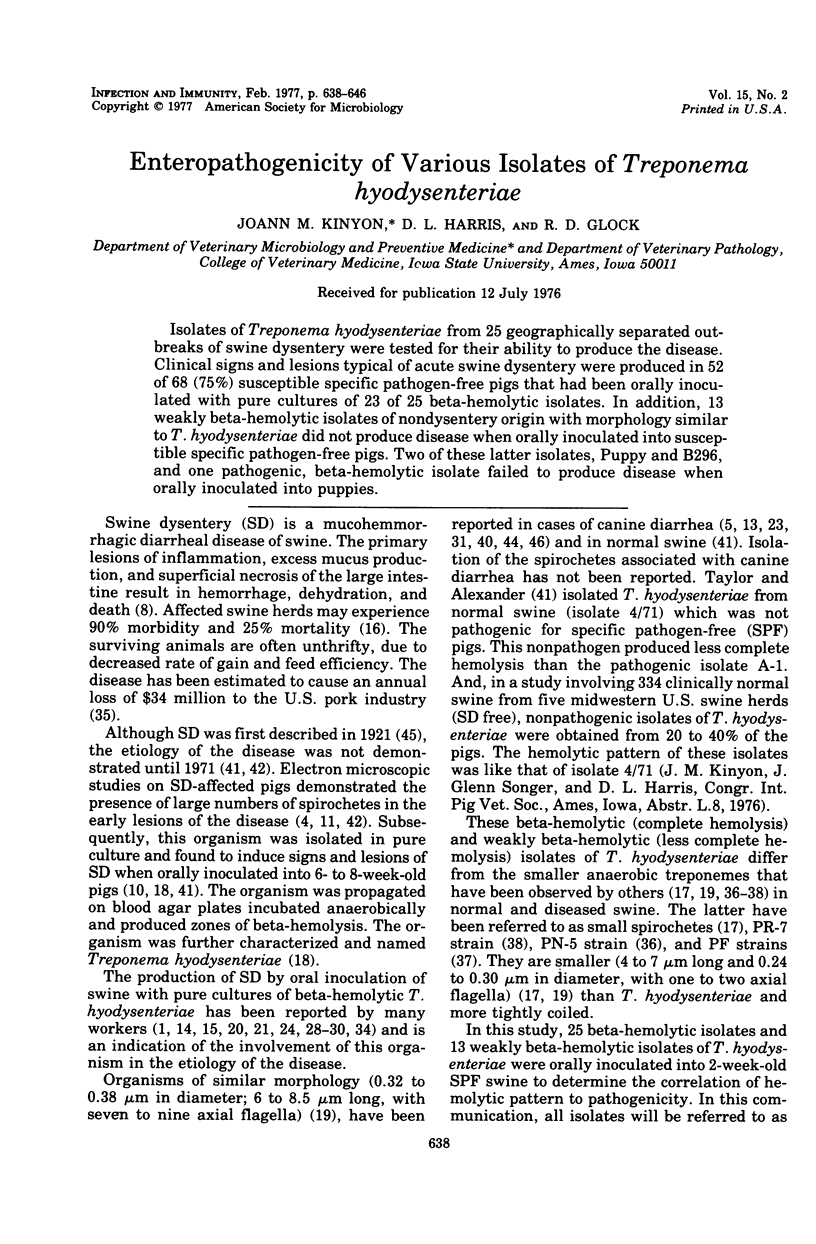

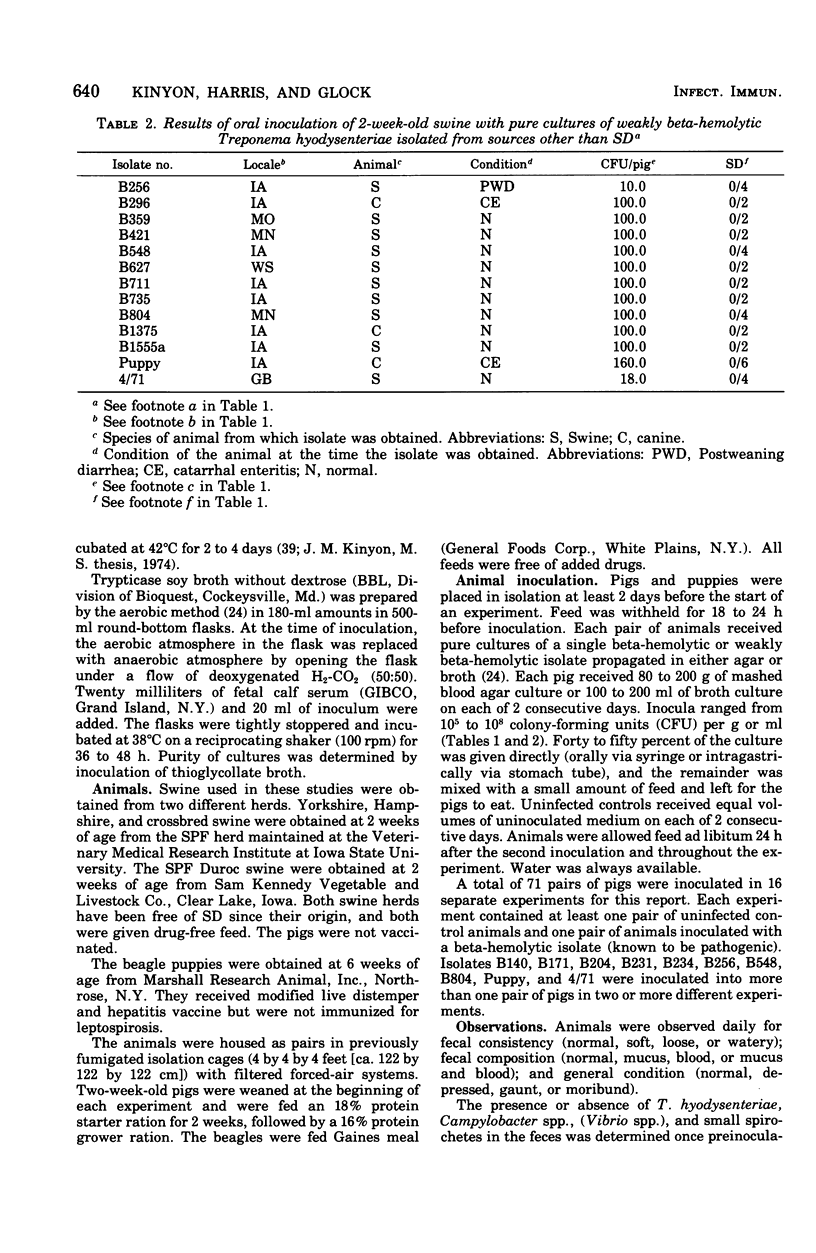

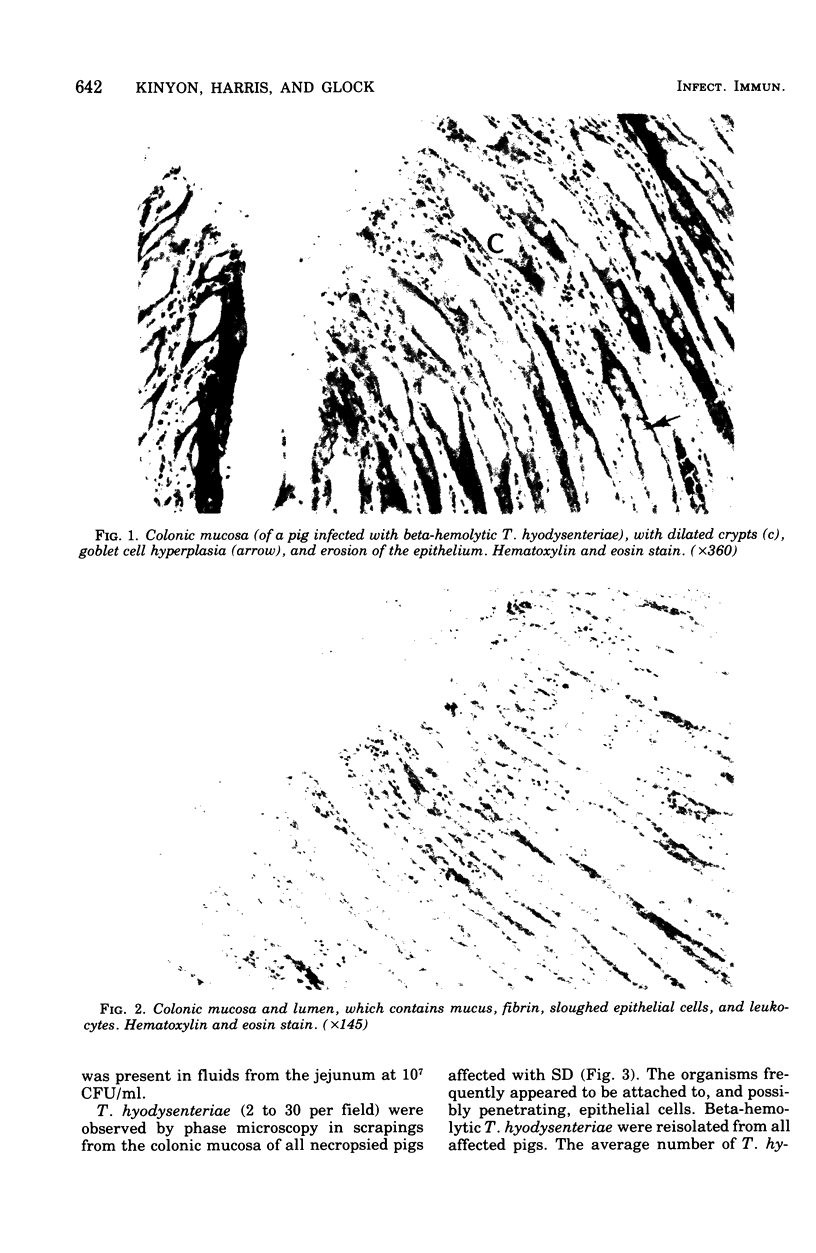


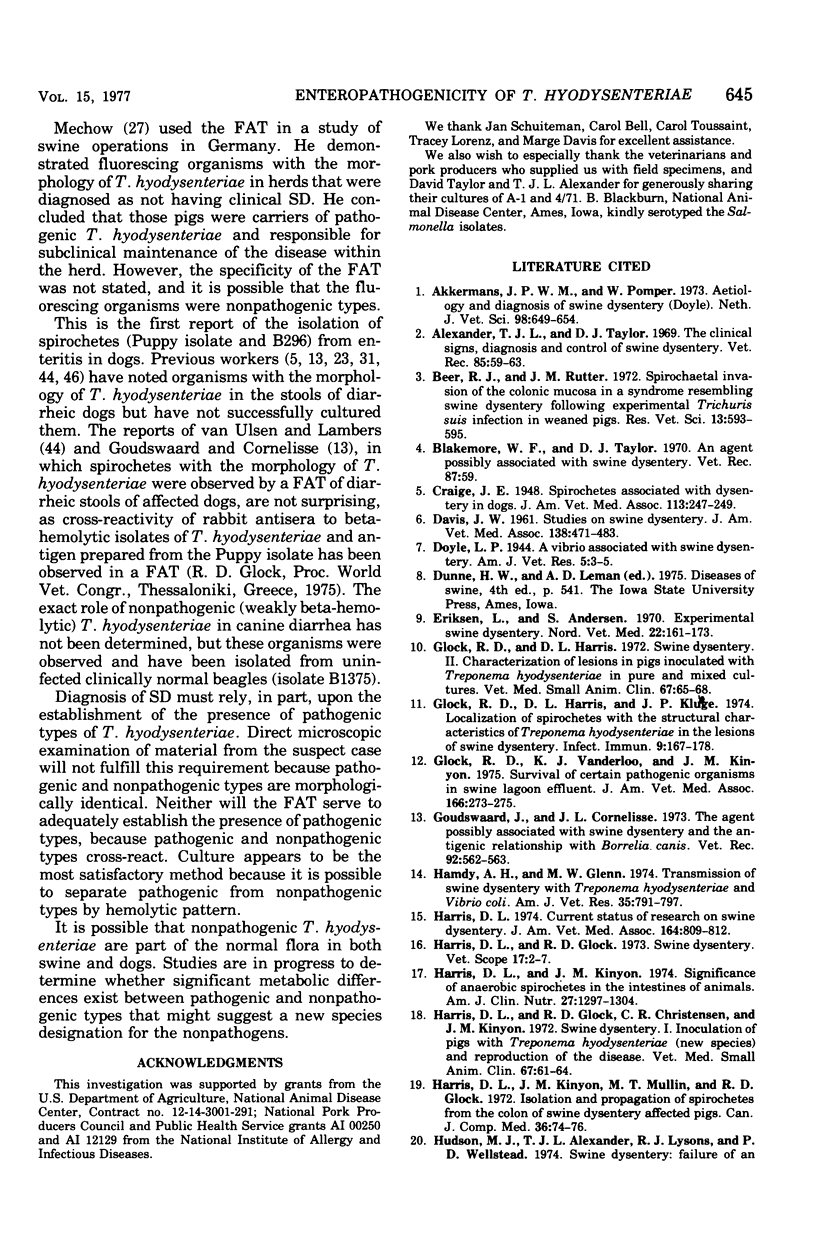
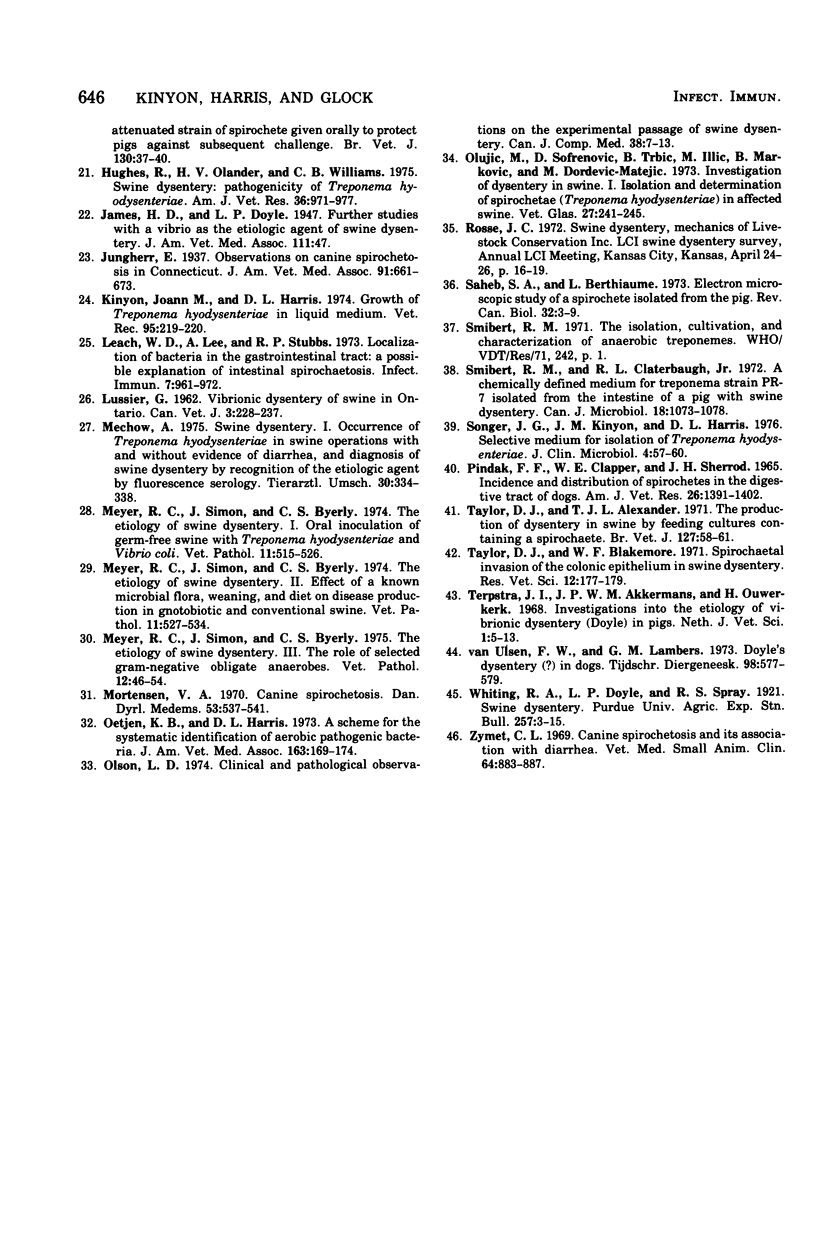
Images in this article
Selected References
These references are in PubMed. This may not be the complete list of references from this article.
- Akkermans J. P., Pomper W. Aetiology and diagnosis of swine dysentery (Doyle). Tijdschr Diergeneeskd. 1973 Jul 15;98(14):649–654. [PubMed] [Google Scholar]
- Alexander T. J., Taylor D. J. The clinical signs, diagnosis and control of swine dysentery. Vet Rec. 1969 Jul 19;85(3):59–63. doi: 10.1136/vr.85.3.59. [DOI] [PubMed] [Google Scholar]
- Beer R. J., Rutter J. M. Spirochaetal invasion of the colonic mucosa in a syndrome resembling swine dysentery following experimental Trichuris suis infection in weaned pigs. Res Vet Sci. 1972 Nov;13(6):593–595. [PubMed] [Google Scholar]
- Blakemore W. F., Taylor D. J. An agent possibly associated with swine dysentery. Vet Rec. 1970 Jul 11;87(2):59–60. doi: 10.1136/vr.87.2.59. [DOI] [PubMed] [Google Scholar]
- DAVIS J. W. Studies on swine dysentery. J Am Vet Med Assoc. 1961 May 1;138:471–483. [PubMed] [Google Scholar]
- Glock R. D., Harris D. L., Kluge J. P. Localization of spirochetes with the structural characteristics of Treponema hyodysenteriae in the lesions of swine dysentery. Infect Immun. 1974 Jan;9(1):167–178. doi: 10.1128/iai.9.1.167-178.1974. [DOI] [PMC free article] [PubMed] [Google Scholar]
- Glock R. D., Harris D. L. Swine dysentery. II. Characterization of lesions in pigs inoculated with Treponema hyodysenteriae in pure and mixed culture. Vet Med Small Anim Clin. 1972 Jan;67(1):65–68. [PubMed] [Google Scholar]
- Glock R. D., Vanderloo K. J., Kinyon J. M. Survival of certain pathogenic organisms in swine lagoon effluent. J Am Vet Med Assoc. 1975 Feb 1;166(3):273–275. [PubMed] [Google Scholar]
- Goudswaard J., Cornelisse J. L. The agent possibly associated with swine dysentery and the antigenic relationship with Borrelia canis. Vet Rec. 1973 May 26;92(21):562–563. doi: 10.1136/vr.92.21.562. [DOI] [PubMed] [Google Scholar]
- Hamdy A. H., Glenn M. W. Transmission of swine dysentery with Treponema hyodysenteriae and Vibrio coli. Am J Vet Res. 1974 Jun;35(6):791–797. [PubMed] [Google Scholar]
- Harris D. L. Current status of research on swine dysentery. J Am Vet Med Assoc. 1974 Apr 15;164(8):809–812. [PubMed] [Google Scholar]
- Harris D. L., Glock R. D., Christensen C. R., Kinyon J. M. Inoculation of pigs with Treponema hyodysenteriae (new species) and reproduction f the disease. Vet Med Small Anim Clin. 1972 Jan;67(1):61–64. [PubMed] [Google Scholar]
- Harris D. L., Kinyon J. M., Mullin M. T., Glock R. D. Isolation and propagation of spirochetes from the colon of swine dysentery affected pigs. Can J Comp Med. 1972 Jan;36(1):74–76. [PMC free article] [PubMed] [Google Scholar]
- Harris D. L., Kinyon J. M. Significance of anaerobic spirochetes in the intestines of animals. Am J Clin Nutr. 1974 Nov;27(11):1297–1304. doi: 10.1093/ajcn/27.11.1297. [DOI] [PubMed] [Google Scholar]
- Hughes R., Olander H. J., Williams C. B. Swine dysentery: pathogenicity of Treponema hyodysenteriae. Am J Vet Res. 1975 Jul;36(7):971–977. [PubMed] [Google Scholar]
- Kinyon J. M., Harris D. L. Growth in Treponema hyodysenteriae in liquid medium. Vet Rec. 1974 Sep 7;95(10):219–220. doi: 10.1136/vr.95.10.219. [DOI] [PubMed] [Google Scholar]
- Leach W. D., Lee A., Stubbs R. P. Localization of bacteria in the gastrointestinal tract: a possible explanation of intestinal spirochaetosis. Infect Immun. 1973 Jun;7(6):961–972. doi: 10.1128/iai.7.6.961-972.1973. [DOI] [PMC free article] [PubMed] [Google Scholar]
- Lussier G. Vibrionic Dysentery of Swine in Ontario-Part I : 1. Clinical Aspects and Pathology. Can Vet J. 1962 Aug;3(8):228–237. [PMC free article] [PubMed] [Google Scholar]
- Meyer R. C., Simon J., Byerly C. S. The etiology of swine dysentery. I. Oral inoculation of germ-free swine with Treponema hyodysenteriae and Vibrio coli. Vet Pathol. 1974;11(6):515–526. doi: 10.1177/030098587401100606. [DOI] [PubMed] [Google Scholar]
- Meyer R. C., Simon J., Byerly C. S. The etiology of swine dysentery. II. Effect of a known microbial flora, weaning and diet on disease production in gnotobiotic and conventional swine. Vet Pathol. 1974;11(6):527–534. doi: 10.1177/030098587401100607. [DOI] [PubMed] [Google Scholar]
- Meyer R. C., Simon J., Byerly C. S. The etiology of swine dysentery. III. The role of selected gram-negative obligate anaerobes. Vet Pathol. 1975;12(1):46–54. doi: 10.1177/030098587501200107. [DOI] [PubMed] [Google Scholar]
- Oetjen K. A., Harris D. L. Scheme for systematic identification of aerobic pathogenic bacteria. J Am Vet Med Assoc. 1973 Jul 15;163(2):169–175. [PubMed] [Google Scholar]
- Olson L. D. Clinical and pathological observations on the experimental passage of swine dysentery. Can J Comp Med. 1974 Jan;38(1):7–13. [PMC free article] [PubMed] [Google Scholar]
- Pindak F. F., Clapper W. E., Sherrod J. H. Incidence and distribution of spirochetes in the digestive tract of dogs. Am J Vet Res. 1965 Nov;26(115):1391–1402. [PubMed] [Google Scholar]
- Saheb S. A., Berthiaume L. Etude au microscope electronique d'un spirochète isolé du porc. Rev Can Biol. 1973 Mar;32(1):3–9. [PubMed] [Google Scholar]
- Smibert R. M., Claterbaugh R. L., Jr A chemically defined medium for Treponema strain PR-7 isolated from the intestine of a pig with swine dysentery. Can J Microbiol. 1972 Jul;18(7):1073–1078. doi: 10.1139/m72-166. [DOI] [PubMed] [Google Scholar]
- Songer J. G., Kinyon J. M., Harris D. L. Selective medium for isolation of Treponema hyodysenteriae. J Clin Microbiol. 1976 Jul;4(1):57–60. doi: 10.1128/jcm.4.1.57-60.1976. [DOI] [PMC free article] [PubMed] [Google Scholar]
- Taylor D. J., Alexander T. J. The production of dysentery in swine by feeding cultures containing a spirochaete. Br Vet J. 1971 Nov;127(11):58–61. doi: 10.1016/s0007-1935(17)37282-2. [DOI] [PubMed] [Google Scholar]
- Taylor D. J., Blakemore W. F. Spirochaetal invasion of the colonic epithelium in swine dysentery. Res Vet Sci. 1971 Mar;12(2):177–179. [PubMed] [Google Scholar]
- Zymet C. L. Canine spirochetosis and its association with diarrhea. Vet Med Small Anim Clin. 1969 Oct;64(10):883–887. [PubMed] [Google Scholar]
- van Ulsen F. W., Lambers G. M. Dysenterie Doyle (?) bij de hond. Tijdschr Diergeneeskd. 1973 Jun 15;98(12):577–579. [PubMed] [Google Scholar]





